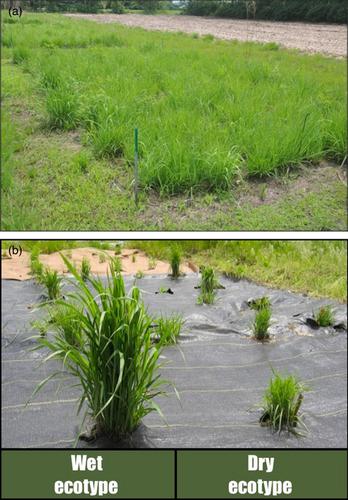Journal of Ecology ( IF 5.5 ) Pub Date : 2021-05-20 , DOI: 10.1111/1365-2745.13695 Loretta C. Johnson 1 , Matthew B. Galliart 1 , Jacob D. Alsdurf 1 , Brian R. Maricle 2 , Sara G. Baer 3 , Nora M. Bello 4 , David J. Gibson 5 , Adam B. Smith 6

|
1 INTRODUCTION
Local adaptation is a fundamental phenomenon in evolutionary biology (Savolainen et al., 2013), with relevance to formation of ecotypes (Clausen et al., 1940; Lowry, 2012; Turesson, 1922) and ultimately new species (Nosil, 2012; Rundle & Nosil, 2005). Reciprocal transplant gardens, an extension of the common garden approach in which ecotypes are transplanted among home and away habitats, are the gold standard to detect local adaptation in populations (Cheplick, 2015). Because habitats often vary over time and space, this variation results in differential selection across climate gradients, genetic divergence among populations, and local adaptation (Linhart & Grant, 1996). A main goal of evolutionary biology is to understand factors that contribute to such population genetic divergence (Mayr, 1963). After almost a century of adaptation studies starting with the seminal common gardens of Turesson (1922) in Europe and later reciprocal transplant gardens of Clausen et al. (1940) in the United States, gaps still exist in knowledge for geographically distributed populations of most plant species (Falk et al., 2006), especially dominant species that control community and ecosystem process (Angelini et al., 2011; McCain et al., 2010; Schweitzer et al., 2012). This gap is in spite of the known relevance of intraspecific variation (Prieto et al., 2015; Raffard et al., 2019) and local adaptation for climate change (Kokko et al., 2017; Nicotra et al., 2010; Shaw & Etterson, 2012), conservation and restoration (Bucharova, 2017; Bucharova et al., 2017; Gibson, Espeland, et al., 2016; Hufford & Mazer, 2003).
Here we review use of reciprocal transplant gardens to detect local adaptation, primarily focusing on grassland species of the Great Plains of the United States. This review comprises five sections: the historical foundation for reciprocal transplant gardens including a literature survey of current trends; a case study illustrating the power of reciprocal transplant gardens focused on a dominant tallgrass prairie species, Andropogon gerardii Vitman, as an emerging ecological genomics model; using reciprocal transplant gardens to link ecology and genomics; opportunities and new frontiers as we enter the 21st century with a new focus on biotic factors; and finally, application to climate change and restoration.
中文翻译:

互惠移植花园作为检测草原物种当地适应性的黄金标准:进入 21 世纪的新机遇
1 简介
局部适应是进化生物学中的一个基本现象 (Savolainen et al., 2013 ),与生态型的形成 (Clausen et al., 1940 ; Lowry, 2012 ; Turesson, 1922 ) 以及最终的新物种 (Nosil, 2012 ; Rundle ) 的形成有关& 诺西尔, 2005 年)。互惠移植花园是在家庭和远离栖息地之间移植生态型的普通花园方法的延伸,是检测种群局部适应情况的黄金标准(Cheplick, 2015)。由于栖息地经常随时间和空间而变化,这种变化导致气候梯度的差异选择、种群之间的遗传差异和局部适应(Linhart & Grant, 1996)。进化生物学的一个主要目标是了解导致这种种群遗传差异的因素(Mayr, 1963)。经过近一个世纪的适应研究,从欧洲的 Turesson ( 1922 ) 开创性的公共花园和后来的 Clausen 等人的互惠移植花园开始。( 1940 ) 在美国,大多数植物物种的地理分布种群的知识仍然存在差距 (Falk et al., 2006),尤其是控制群落和生态系统过程的优势物种 (Angelini et al., 2011 ; McCain et al., 2010 ; Schweitzer et al., 2012 )。尽管已知种内变异(Prieto 等人, 2015;Raffard 等人, 2019 年)和气候变化的局部适应(Kokko 等人, 2017 年;Nicotra 等人, 2010 年;Shaw & Eterson, 2012 年),保护和恢复(Bucharova, 2017 年;Bucharova 等人, 2017 年;Gibson, Espeland 等人, 2016 年;Hufford & Mazer, 2003 年)。
在这里,我们回顾了使用互惠移植花园来检测当地适应情况,主要关注美国大平原的草原物种。本综述包括五个部分:互惠移植花园的历史基础,包括对当前趋势的文献调查;一个案例研究说明了互惠移植花园的力量,重点关注主要的高草草原物种Andropogon gerardii Vitman,作为一种新兴的生态基因组学模型;使用互惠移植花园将生态学和基因组学联系起来;随着我们进入 21 世纪,我们将新的焦点放在生物因素上,机会和新的前沿;最后,应用于气候变化和恢复。

























 京公网安备 11010802027423号
京公网安备 11010802027423号